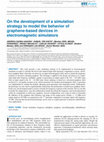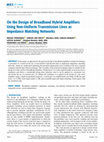Papers by Samuel Ver Hoeye
A Novel Surface-Independent Textile Fully Woven UHF RFID Tag
IEEE Transactions on Antennas and Propagation
2019 International Conference on Electromagnetics in Advanced Applications (ICEAA)
A novel modelling technique to design microwave 3D-printable filters based on arbitrarily height-... more A novel modelling technique to design microwave 3D-printable filters based on arbitrarily height-modulated substrate integrated waveguides (SIW) is presented in this paper. In the literature, different topologies have been already employed to design filters based on SIW. Nevertheless, none of these solutions have analyzed the behavior of the modulation of the height of the filters. This is due to the difficulty of manufacturing the prototypes with conventional procedures. In this paper, the techniques to design and manufacture these filters, provided with microstrip transitions for their validation, are presented.
Harmonic Optimization of Rationally
A new optimization technique is presented for the design of synchronized oscillators with a ratio... more A new optimization technique is presented for the design of synchronized oscillators with a rational ratio between the input- and output-frequency. The synchronization bandwidth is increased through the generation of the optimum harmonic components of the oscillator- and the input-signal by means of a multi-harmonic load. The synchronization loci are calculated for different values of these harmonic components by means of the use of an auxiliary generator. A 5-3.75 GHz rationally synchronized oscillator has been designed and optimized to obtain a maximum synchronization bandwidth, obtaining a good agreement between the simulated and experimental results. Index Terms—Circuit design, frequency divider (FD), harmonic balance, injection locked oscillators, optimization methods.

IEEE Access, 2019
This work presents a new simulation strategy to be implemented in electromagnetic simulators in o... more This work presents a new simulation strategy to be implemented in electromagnetic simulators in order to calculate the level of the induced high-order harmonic components in mono-and bilayer graphene flakes when they are driven by an input electromagnetic field, and to evaluate the frequency response of structures including graphene. The technique is applied to the design and analysis of a singlestage high-order frequency multiplier capable of generating an output signal in the 220 -330 GHz range from an input signal in the 26 -40 GHz band, whose topology is based on a structured graphene sheet enclosed in a waveguide resonant cavity which maximizes the incident electromagnetic field. A prototype was implemented to validate the method, obtaining good agreement with simulation results. Furthermore, the prototype was also used to experimentally characterize the performance of multi-layer graphene sheets. In this case, the developed model is used to calculate the frequency response of the structure, but it is not able to predict the output power, since the mathematical model describing the frequency conversion phenomena cannot be extrapolated to multi-layer graphene. Several configurations were tested in order to determine the influence of the graphene sheet thickness and shape on the output power. Finally, a -33 dBm level output signal at 280 GHz was generated as the 7 th harmonic component of an input signal with frequency 40 GHz, showing that the presented prototype can be used as a signal generator in practical submillimeter wave applications.

Global Symposium on Millimeter-Waves (GSMM), 2015
This work presents a millimeter/submillimeter wave frequency receiver integrating a graphene subh... more This work presents a millimeter/submillimeter wave frequency receiver integrating a graphene subharmonic mixer and a diagonal horn antenna. The device receives the RF signal through the diagonal horn antenna directly connected to the WR-3 input of the mixer. The desired frequency mixing performance is obtained using the non-linear behavior of a fewlayer graphene film placed on a microstrip line gap. Using the internally generated 6 th , 8 th and 10 th harmonic components of the input signal provided by the WR-28 standard waveguide in the 26-40 GHz the downconversion operation of the RF signal to a 300 MHz intermediate frequency is performed. A prototype of the receiver has been manufactured using high precision 3D printing technology. The performance of this device is characterized taking into account the behavior of the IF power in the 220-330 GHz band. Measured radiation patterns are also included.
Techniques for oscillator nonlinear optimization and phase-noise analysis using commercial harmonic-balance software
2000 IEEE MTT-S International Microwave Symposium Digest (Cat. No.00CH37017), 2000
Two new techniques for microwave oscillator design are presented for user implementation on comme... more Two new techniques for microwave oscillator design are presented for user implementation on commercial harmonic-balance simulators: an easy-to-use nonlinear optimization technique and a phase-noise analysis technique that makes use of the impulse-sensitivity function. This method is implemented for the first time on a harmonic-balance simulator. Simulation results of a MMIC VCO in the Ku-band have been compared with measurements
Transmitting active antenna array based on fourth harmonic oscillators for low power point-to-point reconfigurable communications
2012 IEEE International Conference on Wireless Information Technology and Systems (ICWITS), 2012
A fourth harmonic oscillator based 4×4 active antenna array has been presented. The fourth harmon... more A fourth harmonic oscillator based 4×4 active antenna array has been presented. The fourth harmonic oscillator circuits generate the carrier at 10 GHz with a level of -15 dBm, whose phase can be controlled in a continuous range greater than 360°. The beam steering capability has been experimentally validated through preliminary radiation pattern measurements. However, an individual measurement of the phase shift distribution in the array may be necessary to compensate for potential phase distribution errors.
Progress In Electromagnetics Research Letters, 2009
In this work, a polarisation agile antenna based on an array of two injection locked oscillators ... more In this work, a polarisation agile antenna based on an array of two injection locked oscillators is presented. The proposed topology provides a theoretical relative phase shift range of 360 degrees between the output signals, which can be easily controlled through two DC voltages. The behaviour of the system is studied, both through simulations and measurements of the manufactured prototype, focusing on the joint performance of the oscillators. The data transmission capabilities of the system are analysed, proposing a solution for phase modulated signals.
Defected Ground Structure for Coupling Reduction between Probe Fed Microstrip Antenna Elements
PIERS Online, 2010
The mutual coupling between elements of a microstrip antenna design based on stacked patches has ... more The mutual coupling between elements of a microstrip antenna design based on stacked patches has been studied in an array conflguration. In order to mitigate the mutual coupling, a defected ground structure based on narrow, closely spaced rectangular slots has been proposed. Two arrangements with three and flve slots have been studied and optimised in an array conflguration with 0:7‚0 element separation. For the experimental validation of the simulated results, prototypes of two element antenna arrays with both DGS designs, as well as without DGS, have been manufactured and measured.
Progress In Electromagnetics Research, 2011
In this work, a nonlinear technique for the optimization of the synchronization bandwidth of Rati... more In this work, a nonlinear technique for the optimization of the synchronization bandwidth of Rationally Synchronized Oscillators (RSO) is presented. The circuit is forced to operate near a Hopf bifurcation point which is created around the frequency of the input reference signal. Under this operating regime, the reference signal is strongly amplified and the synchronization bandwidth of the circuit is considerably improved. A 5-3 GHz rationally synchronized oscillator has been optimized using the proposed method. The manufactured RSO provides a 5 MHz synchronization bandwidth with a reference signal power of -22 dBm, in good agreement with simulation results.
Analysis of the Locking Range of Rationally Synchronized Oscillators With High Reference Signal Power
IEEE Transactions on Microwave Theory and Techniques, 2012
ABSTRACT In this paper an in-depth study of the behavior of rationally synchronized oscillators (... more ABSTRACT In this paper an in-depth study of the behavior of rationally synchronized oscillators (RSO) is presented. The circuit is optimized in order to achieve a broad synchronization bandwidth with low reference signal power through the selection of the adequate harmonic content. The nonlinear dynamics of the RSO is analyzed, focusing on the different bifurcation points which delimit the locking range when high reference signal power is considered. An RSO prototype with rational synchronization ratio r=3/5, autonomous frequency fo=3 GHz and reference signal frequency fr=5 GHz has been manufactured and experimentally characterized, demonstrating a good agreement with simulation results.
Harmonic Optimization of Rationally Synchronized Oscillators
IEEE Microwave and Wireless Components Letters, 2009
A new optimization technique is presented for the design of synchronized oscillators with a ratio... more A new optimization technique is presented for the design of synchronized oscillators with a rational ratio between the input- and output-frequency. The synchronization bandwidth is increased through the generation of the optimum harmonic components of the oscillator- and the input-signal by means of a multi-harmonic load. The synchronization loci are calculated for different values of these harmonic components by means of the use of an auxiliary generator. A 5-3.75 GHz rationally synchronized oscillator has been designed and optimized to obtain a maximum synchronization bandwidth, obtaining a good agreement between the simulated and experimental results.
IEEE Antennas and Propagation Magazine, 2019
A novel multifunctional fully textile integrated radiofrequency identification tag has been desig... more A novel multifunctional fully textile integrated radiofrequency identification tag has been designed, simulated and experimentally verified. The tag, which works at 13.56 MHz, is based on the inductive coupling phenomenon. It has been designed to be hidden from touch and sight, while being largescale manufacturable. The manufactured prototype has been characterised and the theoretically predicted behaviour of the tag has been experimentally verified.

IEEE Access, 2019
In this paper, an approach for the practical design of broadband amplifiers in hybrid technology ... more In this paper, an approach for the practical design of broadband amplifiers in hybrid technology is presented. It is based on the use of non-uniform transmission lines to implement impedance matching networks, which are synthesized exploiting the powerful optimization tools available in the most common computer-aided design software packages. The versatility of the proposed technique makes it suitable for the design of a wide variety of broadband amplifiers. Furthermore, it is easily implementable in most microwave simulators and allows a considerable design time reduction, since it can be applied in a systematic way and avoids the use of external tools. To validate the technique, it is applied to the design of a low noise amplifier using a single encapsulated transistor. A prototype was implemented, providing 10-dB flat gain from 1 to 12 GHz, noise figure under 2.5 dB, and acceptable input and output matching, which agrees with the simulation data.

IEEE Access, 2018
This paper presents a complete and enhanced description of a parametric characterization and an e... more This paper presents a complete and enhanced description of a parametric characterization and an electromagnetic analysis technique in order to simulate complex woven structures for the design of wearable microwave circuits and antennas based on smart textile. On the one hand, the parametric characterization consists of achieving the mathematical models which describe the different patterns conformed by the threads of the woven structures. This characterization takes into account the possible deformations of the materials inside the woven structure. On the other hand, the electromagnetic analysis technique consists of studying the conductive or dielectric parameters which describe the materials from which the threads have been extruded, and predicting the electromagnetic behavior of whole woven structures using the already explained parametric characterization. For this purpose, three different, although electromagnetically equivalent, models of the involved materials are needed, which subsequently reduce the computational resources required in the simulations. As a result, the woven structures can be characterized from the involved threads and the electromagnetic behavior can be analyzed in order to design wearable antennas or circuits.
Millimetre wave transmitter based on a few-layer graphene frequency multiplier
2015 European Microwave Conference (EuMC), 2015
In this work, a millimetre/submillimetre wave transmitter prototype integrating a graphene based ... more In this work, a millimetre/submillimetre wave transmitter prototype integrating a graphene based frequency multiplier and a diagonal horn antenna is presented. With a driving signal in the WR-28 frequency band (26.5-40 GHz), an output signal in the WR-3 frequency band (220-330 GHz) is generated and radiated. A prototype has been manufactured using high precision 3D printing techniques. The performance with multiplication orders 5, 7 and 9 has been compared, obtaining maximum power levels of about -45 dBm, measured at a distance of 250 mm. Measured radiation patterns are also presented.
Millimetre wave receiver based on a few-layer graphene WR-5 band subharmonic mixer
Global Symposium on Millimeter-Waves (GSMM), 2015
In this work, a millimetre wave receiver prototype integrating a graphene based subharmonic mixer... more In this work, a millimetre wave receiver prototype integrating a graphene based subharmonic mixer and a diagonal horn antenna is presented. The block receives a millimetre wave signal in the WR-5 frequency band (140-220 GHz), which is downconverted using a high-order harmonic component of the local oscillator signal, in the WR-28 frequency band (26.5-40 GHz), producing an IF output at 300 MHz. A prototype has been manufactured using high precision 3D printing techniques. The performance for subharmonic orders 6, 8 and 10 has been evaluated through preliminary measurements in the neighbouring WR-3 frequency band. Measured radiation patterns are also presented.
7<SUP>TH</SUP> Order Sub-Millimeter Wave Frequency Multiplier Based on Graphene Implemented Using a Microstrip Transition Between Two Rectangular Waveguides
2014 International Conference on Electromagnetics in Advanced Applications (ICEAA), 2014
ABSTRACT In this work, a 7th order sub-millimeter wave frequency multiplier for Terahertz applica... more ABSTRACT In this work, a 7th order sub-millimeter wave frequency multiplier for Terahertz applications is presented. The multiplier is based on a microstrip line with a small gap where a graphene film layer is deposited. The multiplication phenomena is reached via the nonlinear behavior of the graphene film using an input signal provided by the WR28 standard waveguide operating in the Ka frequency band (31 to 40 GHz). A prototype of the multiplier has been manufactured and the behavior of the output power in the 220-280 GHz band versus the input power has been experimentally characterized.

Non-linear design, optimization and analysis of an injection-locked high efficiency VCO with arbitrarily width modulated microstrip line networks
2014 International Telecommunications Symposium (ITS), 2014
In this work a non-linear efficiency optimization method for its application to a high efficiency... more In this work a non-linear efficiency optimization method for its application to a high efficiency Voltage Controlled Oscillator is presented. The technique is founded on the use of an auxiliary generator and several multi-harmonic loads based on Arbitrarily Width-Modulated Microstrip Lines to ensure the convergence of the optimization process. A 2.5 GHz high efficiency VCO has been designed and synchronized with an external signal. Then, a detailed analysis of the efficiency of all the possible synchronized solutions of the injection locked VCO is presented. Finally, to validate the technique, a prototype has been implemented and experimentally characterized, obtaining a good agreement between the simulated and measured results.
Uploads
Papers by Samuel Ver Hoeye